The Turtle Bay Security Roundtable: Building Technologies of Trust
2019/3/15
On March 15, 2019, the Permanent Mission of Japan to the United Nations, together with the Stimson Center, hosted the 10th meeting of the Turtle Bay Security Roundtable series. This session was the last of three roundtables held under the theme “Managing the Frontiers of Technology.” While the prior two, both in 2018, had focused on the risks posed by emerging technologies, this session explored potential benefits and positive applications.
The event featured:
OPENING REMARKS
Ambassador Koro Bessho (Permanent Mission of Japan)
Ambassador Bessho gave the opening remarks. He emphasized the capacity of satellite imagery to provide greater transparency in arms control, disarmament, and nonproliferation, and noted that distributed ledger technologies held the promise of safeguarding the accounting of nuclear materials. He encouraged participants to consider the necessity of balancing the security risks with the prospective benefits that these technologies, if properly managed, could bring to humanity. The Ambassador also noted that the Turtle Bay Security Roundtable series was a rare opportunity for subject matter experts to engage with diplomats in an open, honest and mutually educational format.
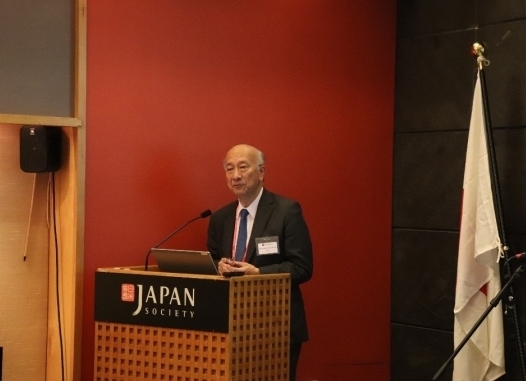
KEYNOTE ADDRESS
Ambassador Amandeep Singh Gill (Executive Director, Secretariat of the High-level Panel on Digital Cooperation)
Speaking by videoconference, Ambassador Gill sought to focus on the positive attributes of advanced technology, particularly given the often over-emphasized security challenges that innovation can yield. He noted the role of previous technological developments, such as permissive action links, in mitigating nuclear security fears after the Cuban Missile Crisis. With a common recognition of the challenges surrounding command and control, and a bilateral space for dialogue among specialists, both sides were able to institute the necessary safeguards. Today, by contrast, the world is suffering from a “trust deficit disorder,” he said, but there was capacity for building trust at the “engine room level” using emerging technologies. Recent successes included the development of regulations in the field of unmanned aerial vehicles. In order to fully capitalize on the benefits of innovation, the manner in which norms and compliance rules are established must change, he said.
Ambassador Gill took questions from attendees as well. He called for a discovery process of values to ensure that technology, once deployed, would be used in a demonstrably ethical way. Soft governance could not replace hard governance, and there cannot be a values wash, he said. For example, with lethal autonomous weapons systems, it is necessary to establish guiding principles before countries move ahead with R&D investments. Speaking to the work of the High-Level Panel, he noted that “We agreed to 10 guiding principles after a year of discussion, including the principle that international humanitarian law continues to apply regardless of weapons system, and human responsibility for deployment of these systems cannot be delegated to machines.”
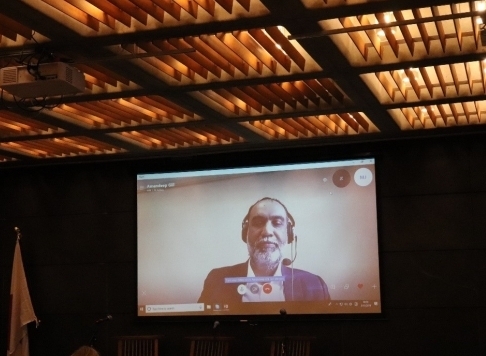
FIRST SESSION: Verifying Peace: Building the Technologies of Trust
Moderator: Richard Cupitt (Stimson Center)
Panelists: Margarita Kalinina-Pohl (Middlebury College), Thomas Ewing (C4ADS)
In the first session, Richard Cupitt asked Margarita Kalinina-Pohl and Thomas Ewing to describe how they apply emerging technologies to security issues.
Kalinina-Pohl and her organization use social media to disseminate information, collect data, and assist governments, mainly countries in the former Soviet Union, in their efforts to secure radioactive sources, in particular “orphan sources” which have fallen out of regulatory control. They were able to provide one such government with a database of 97 facilities with over a thousand people who would be potential subjects for interviews about the locations of radioactive sources.
Ewing uses big data and data integration to study issues of conflict, corruption, crimes, illicit activities, and sanctions. This is possible thanks to the unprecedented online availability of so much information, particularly about economic activities. Any sort of illicit networks leave a trail, whether in registering a company, sending out a wire transfer, or buying a property, and increasingly that trail is digital and open and analyzable by organizations like C4ADS and anyone with an internet connection. Ewing and his team integrate multiple seemingly unrelated data sources into one chosen format to produce new insights that aren’t obvious from looking at each source alone. (For example, combining labor authorizations and the registry of corporate ownership, both published by the Russian government, to analyze the system of North Korean laborers in Russia).
In addition to this, Ewing explained how C4ADS analyzed several years of AIS (Automatic Identification System) data on every large-scale vessel in the world to figure out the location and time and movements of vessels engaging in illicit activities.
Cupitt asked the panelists to raise some challenges that they faced in applying these technologies to security issues. Kalinina-Pohl said that although social media played a positive role as a platform to provide information voluntarily, users could also decide not to provide information even to official regulatory agencies, for example due a to lack of trust in the government. Ewing also noted the trust question. Because different countries are creating different data management regimes, data in one sphere would be hard to interact with data in another sphere. Cupitt pointed out a similar case where the IAEA received a large amount of data through the reporting of Member States, but could not share this information with anyone else because the Agency felt constrained by its own rules.
SECOND SESSION: Distributed Ledger Technologies in the Pursuit of Peace
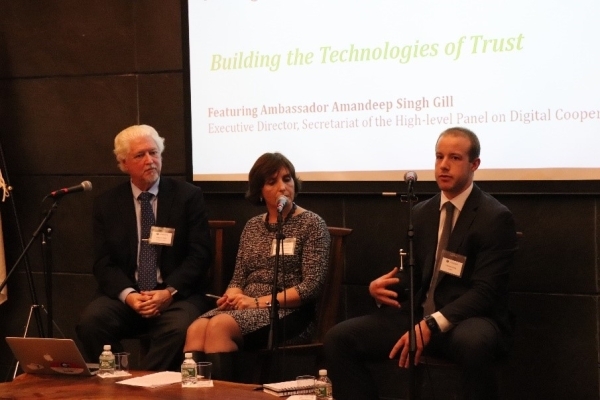
Moderator: Cindy Vestergaard (Stimson Center)
Panelists: Sara Frazer (Pacific Northwest National Laboratory), Donna Dillenberger (IBM)
After lunch, Vestergaard moderated a discussion on distributed ledger technology (DLT) with Dillenberger and Frazer.
Blockchain was initially constructed as a decentralized information system to build trust without depending on one nation or computer. But while “blockchain 1.0” lacked privacy in transactions, Enterprise Blockchain, or “blockchain 2.0,” held still greater promise, and large food companies are already using it to increase food safety, Dillenberger said.
Frazer said that in a politically charged environment, DLT would not replace the IAEA’s essential role, but nonetheless had great potential. Safeguards fundamentally involve auditing sensitive information with a need for data integrity, which is precisely what blockchain is for. Blockchain has multiple layers of encryption and is highly secure.
Hackers can access data due to lack of encryption, or by acquiring the encryption key, or by breaking into the system itself, said Dillenberger. She said that IBM had developed ways to prevent hackers from accessing this data, and, particularly after the Edward Snowden episode, had developed systems where even IBM’s own administrators were now unable to access all data or applications, even in response to requests from the US Government.
A questioner from the audience noted that only a third of Member States submit reports, as requested by a 28-year old General Assembly resolution, on arms transfers. Dillenberger said that whereas a major food distributor, for example, could require its suppliers to report, the UN could only suggest and encourage it. It was unclear how many Member States would need to participate in a ledger to make it worthwhile. Also, nuclear weapons states do not currently have to report small amounts—less than 1 kilogram—of shipments even when shipping to non-nuclear weapons states, so there would be no matching for these transfers. It might therefore be necessary for nuclear weapons states to begin reporting such transfers. The best vote of confidence in such a system would be greater participation from the Member States. The IAEA could make participation a requirement, but this would take a long time.
An attendee who was a member of the Security Council’s DPRK sanctions committee noted that many actors seek to bypass restrictions, and the only way to stop private actors from engaging in illicit transfers was to introduce better end use verifications on companies that make relevant equipment and technologies and ensure that it could be known who owns a particular bank account, etc. “It doesn’t look good for a company when their widgets end up in North Korea,” said Vestergaard.
It remained difficult to ensure that accurate data would be put into the DLT system, and it would be difficult to change inaccurate data, the panelists agreed. Member States would not want to share sensitive information on a blockchain that could be publicly viewed. “One must balance those constraints of a highly regulated system against the benefits of transparency,” said Frazer.
The panelists agreed that DLT was here to stay and it was rapidly evolving.
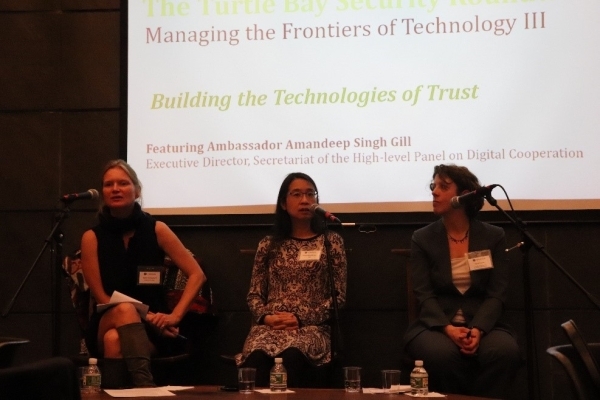
TURTLE BAY CHAT
Moderator: Brian Finlay (Stimson Center)
Featuring: Fabrizio Hoschschild Drummond (Executive Office of the Secretary-General)
In the new segment, the “Turtle Bay Chat,” attendees were able to dialogue with Assistant Secretary-General Drummond. Drummond said that things were moving fast at the UN, notably in the humanitarian sphere, which was critical because more effective use of funding saves lives. “In New York, we still pay with checks, but WFP is doing food distributions in the remotest parts of the world using blockchain, iris scanning, and more, very high-tech mechanisms to reduce the potential for food going to waste or being lost,” he said. UNICEF was using satellite data, AI, and internet outreach to figure out which schools in the Sahel had internet coverage and which ones did not. UNAIDS was using AI to track tuberculosis, which was often connected with HIV positivity. The UN was analyzing speech patterns and the use of hate speech in social media to indicate the potential onset of conflict. Peacekeeping missions were using quad-copters and high-altitude balloons to track the movement of armed groups.
Asked if the international security sphere had fallen behind technologically, Drummond said that the pressure for innovation was much greater where there were limited resources and a lack of well-entrenched bureaucracy. Agencies needed leadership from the top, not just through rhetorical commitment but through a strategy, and it was necessary to tap into the expertise of young people in the organization. Previous innovation waves had mostly been government-led, but now governments are playing catchup with the private sector, and need to better engage with industry.
Asked about the potential for technology to reduce inequality within and between states, Drummond said early results were mixed. India, China, Kenya, and Rwanda had adapted early to new technologies and there is great optimism and international cooperation, but this needs to be guided and supported. It was also necessary to be cautious about the possibility of skipping from the Second to the Fourth Industrial Revolution. “In sub-Saharan Africa 87% of people have no electricity access, so the likelihood of being left behind by a digitally advancing world is high,” he said. “Parts of the world have phone access but no clean drinking water. We still need to address other development needs.” Moreover, discrimination and inequality endured, with the proportion of women connected to the internet globally still 50% less than men in 2019.
Drummond closed with a call for all actors to learn from each other. Government leaders need to know more about emerging technologies, but people in the tech industry need to learn more about the social, political, and economic consequences of their inventions, and about possible malicious uses.
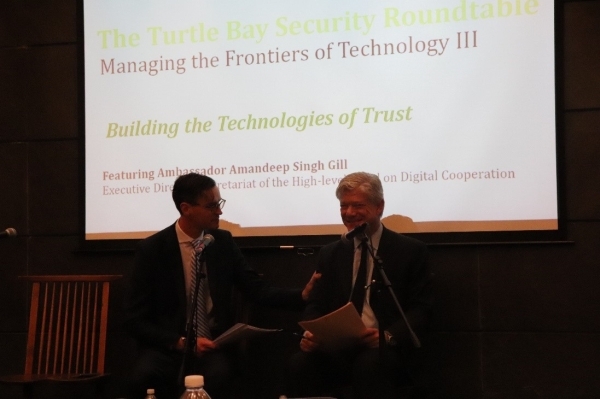
CLOSING REMARKS
Ambassador Koro Bessho (Permanent Mission of Japan)
Concluding the proceedings, Ambassador Bessho thanked the panelists and attendees. Some of the panelists were more pessimistic than others, but all shared the view that emerging technologies held many positive possibilities. The roundtable series would continue, he said, and a new topic and list of speakers would be announced in the coming months.
The event featured:
- a keynote address by Amandeep Singh Gill, Executive Director, Secretariat of the High-level Panel on Digital Cooperation;
- two discussions, one on technologies of trust featuring Margarita Kalinina-Pohl (Center for Nonproliferation Studies, Middlebury College) and Thomas Ewing (C4ADS), and another on the peaceful applications of distributed ledger technologies featuring Sarah Frazer (Pacific Northwest National Laboratory) and Donna Dillenberger (IBM); and
- a new segment, the “Turtle Bay chat,” with Fabrizio Hochschild Drummond, Assistant Secretary-General for Strategic Coordination, Executive Office of the Secretary-General (EODG).
OPENING REMARKS
Ambassador Koro Bessho (Permanent Mission of Japan)
Ambassador Bessho gave the opening remarks. He emphasized the capacity of satellite imagery to provide greater transparency in arms control, disarmament, and nonproliferation, and noted that distributed ledger technologies held the promise of safeguarding the accounting of nuclear materials. He encouraged participants to consider the necessity of balancing the security risks with the prospective benefits that these technologies, if properly managed, could bring to humanity. The Ambassador also noted that the Turtle Bay Security Roundtable series was a rare opportunity for subject matter experts to engage with diplomats in an open, honest and mutually educational format.

KEYNOTE ADDRESS
Ambassador Amandeep Singh Gill (Executive Director, Secretariat of the High-level Panel on Digital Cooperation)
Speaking by videoconference, Ambassador Gill sought to focus on the positive attributes of advanced technology, particularly given the often over-emphasized security challenges that innovation can yield. He noted the role of previous technological developments, such as permissive action links, in mitigating nuclear security fears after the Cuban Missile Crisis. With a common recognition of the challenges surrounding command and control, and a bilateral space for dialogue among specialists, both sides were able to institute the necessary safeguards. Today, by contrast, the world is suffering from a “trust deficit disorder,” he said, but there was capacity for building trust at the “engine room level” using emerging technologies. Recent successes included the development of regulations in the field of unmanned aerial vehicles. In order to fully capitalize on the benefits of innovation, the manner in which norms and compliance rules are established must change, he said.
Ambassador Gill took questions from attendees as well. He called for a discovery process of values to ensure that technology, once deployed, would be used in a demonstrably ethical way. Soft governance could not replace hard governance, and there cannot be a values wash, he said. For example, with lethal autonomous weapons systems, it is necessary to establish guiding principles before countries move ahead with R&D investments. Speaking to the work of the High-Level Panel, he noted that “We agreed to 10 guiding principles after a year of discussion, including the principle that international humanitarian law continues to apply regardless of weapons system, and human responsibility for deployment of these systems cannot be delegated to machines.”

FIRST SESSION: Verifying Peace: Building the Technologies of Trust
Moderator: Richard Cupitt (Stimson Center)
Panelists: Margarita Kalinina-Pohl (Middlebury College), Thomas Ewing (C4ADS)
In the first session, Richard Cupitt asked Margarita Kalinina-Pohl and Thomas Ewing to describe how they apply emerging technologies to security issues.
Kalinina-Pohl and her organization use social media to disseminate information, collect data, and assist governments, mainly countries in the former Soviet Union, in their efforts to secure radioactive sources, in particular “orphan sources” which have fallen out of regulatory control. They were able to provide one such government with a database of 97 facilities with over a thousand people who would be potential subjects for interviews about the locations of radioactive sources.
Ewing uses big data and data integration to study issues of conflict, corruption, crimes, illicit activities, and sanctions. This is possible thanks to the unprecedented online availability of so much information, particularly about economic activities. Any sort of illicit networks leave a trail, whether in registering a company, sending out a wire transfer, or buying a property, and increasingly that trail is digital and open and analyzable by organizations like C4ADS and anyone with an internet connection. Ewing and his team integrate multiple seemingly unrelated data sources into one chosen format to produce new insights that aren’t obvious from looking at each source alone. (For example, combining labor authorizations and the registry of corporate ownership, both published by the Russian government, to analyze the system of North Korean laborers in Russia).
In addition to this, Ewing explained how C4ADS analyzed several years of AIS (Automatic Identification System) data on every large-scale vessel in the world to figure out the location and time and movements of vessels engaging in illicit activities.
Cupitt asked the panelists to raise some challenges that they faced in applying these technologies to security issues. Kalinina-Pohl said that although social media played a positive role as a platform to provide information voluntarily, users could also decide not to provide information even to official regulatory agencies, for example due a to lack of trust in the government. Ewing also noted the trust question. Because different countries are creating different data management regimes, data in one sphere would be hard to interact with data in another sphere. Cupitt pointed out a similar case where the IAEA received a large amount of data through the reporting of Member States, but could not share this information with anyone else because the Agency felt constrained by its own rules.
SECOND SESSION: Distributed Ledger Technologies in the Pursuit of Peace

Moderator: Cindy Vestergaard (Stimson Center)
Panelists: Sara Frazer (Pacific Northwest National Laboratory), Donna Dillenberger (IBM)
After lunch, Vestergaard moderated a discussion on distributed ledger technology (DLT) with Dillenberger and Frazer.
Blockchain was initially constructed as a decentralized information system to build trust without depending on one nation or computer. But while “blockchain 1.0” lacked privacy in transactions, Enterprise Blockchain, or “blockchain 2.0,” held still greater promise, and large food companies are already using it to increase food safety, Dillenberger said.
Frazer said that in a politically charged environment, DLT would not replace the IAEA’s essential role, but nonetheless had great potential. Safeguards fundamentally involve auditing sensitive information with a need for data integrity, which is precisely what blockchain is for. Blockchain has multiple layers of encryption and is highly secure.
Hackers can access data due to lack of encryption, or by acquiring the encryption key, or by breaking into the system itself, said Dillenberger. She said that IBM had developed ways to prevent hackers from accessing this data, and, particularly after the Edward Snowden episode, had developed systems where even IBM’s own administrators were now unable to access all data or applications, even in response to requests from the US Government.
A questioner from the audience noted that only a third of Member States submit reports, as requested by a 28-year old General Assembly resolution, on arms transfers. Dillenberger said that whereas a major food distributor, for example, could require its suppliers to report, the UN could only suggest and encourage it. It was unclear how many Member States would need to participate in a ledger to make it worthwhile. Also, nuclear weapons states do not currently have to report small amounts—less than 1 kilogram—of shipments even when shipping to non-nuclear weapons states, so there would be no matching for these transfers. It might therefore be necessary for nuclear weapons states to begin reporting such transfers. The best vote of confidence in such a system would be greater participation from the Member States. The IAEA could make participation a requirement, but this would take a long time.
An attendee who was a member of the Security Council’s DPRK sanctions committee noted that many actors seek to bypass restrictions, and the only way to stop private actors from engaging in illicit transfers was to introduce better end use verifications on companies that make relevant equipment and technologies and ensure that it could be known who owns a particular bank account, etc. “It doesn’t look good for a company when their widgets end up in North Korea,” said Vestergaard.
It remained difficult to ensure that accurate data would be put into the DLT system, and it would be difficult to change inaccurate data, the panelists agreed. Member States would not want to share sensitive information on a blockchain that could be publicly viewed. “One must balance those constraints of a highly regulated system against the benefits of transparency,” said Frazer.
The panelists agreed that DLT was here to stay and it was rapidly evolving.

TURTLE BAY CHAT
Moderator: Brian Finlay (Stimson Center)
Featuring: Fabrizio Hoschschild Drummond (Executive Office of the Secretary-General)
In the new segment, the “Turtle Bay Chat,” attendees were able to dialogue with Assistant Secretary-General Drummond. Drummond said that things were moving fast at the UN, notably in the humanitarian sphere, which was critical because more effective use of funding saves lives. “In New York, we still pay with checks, but WFP is doing food distributions in the remotest parts of the world using blockchain, iris scanning, and more, very high-tech mechanisms to reduce the potential for food going to waste or being lost,” he said. UNICEF was using satellite data, AI, and internet outreach to figure out which schools in the Sahel had internet coverage and which ones did not. UNAIDS was using AI to track tuberculosis, which was often connected with HIV positivity. The UN was analyzing speech patterns and the use of hate speech in social media to indicate the potential onset of conflict. Peacekeeping missions were using quad-copters and high-altitude balloons to track the movement of armed groups.
Asked if the international security sphere had fallen behind technologically, Drummond said that the pressure for innovation was much greater where there were limited resources and a lack of well-entrenched bureaucracy. Agencies needed leadership from the top, not just through rhetorical commitment but through a strategy, and it was necessary to tap into the expertise of young people in the organization. Previous innovation waves had mostly been government-led, but now governments are playing catchup with the private sector, and need to better engage with industry.
Asked about the potential for technology to reduce inequality within and between states, Drummond said early results were mixed. India, China, Kenya, and Rwanda had adapted early to new technologies and there is great optimism and international cooperation, but this needs to be guided and supported. It was also necessary to be cautious about the possibility of skipping from the Second to the Fourth Industrial Revolution. “In sub-Saharan Africa 87% of people have no electricity access, so the likelihood of being left behind by a digitally advancing world is high,” he said. “Parts of the world have phone access but no clean drinking water. We still need to address other development needs.” Moreover, discrimination and inequality endured, with the proportion of women connected to the internet globally still 50% less than men in 2019.
Drummond closed with a call for all actors to learn from each other. Government leaders need to know more about emerging technologies, but people in the tech industry need to learn more about the social, political, and economic consequences of their inventions, and about possible malicious uses.

CLOSING REMARKS
Ambassador Koro Bessho (Permanent Mission of Japan)
Concluding the proceedings, Ambassador Bessho thanked the panelists and attendees. Some of the panelists were more pessimistic than others, but all shared the view that emerging technologies held many positive possibilities. The roundtable series would continue, he said, and a new topic and list of speakers would be announced in the coming months.
